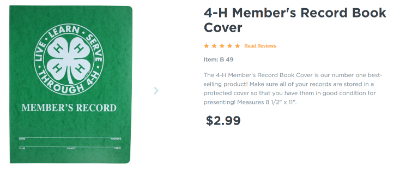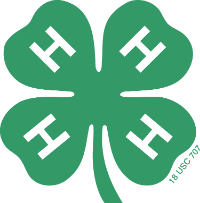Record Books & Project Completion
Record Books
The 4-H program has a long history of record keeping. The focus reflects the importance of this life skill in our daily lives. In 4-H, young people have tracked their activities, events, profits and losses, skill development and learning experiences. In addition to record keeping, 4-H record books enhance learning by encouraging members to reflect on their year, measure their achievements and growth, set goals, and develop action plans to meet those goals.
Why have 4-H record books?
4-H record books serve a variety of purposes in the Montana 4-H program. Record books:
- Provide members an opportunity toreflect on their yearly work. They document their skill development and their learning experiences in a written report. 4-H members measure their achievements and growth in their total years in 4-H.
- Encourage members to set goals, pursue strategies to meet those goals, and to shift gears in the face of challenges and obstacles.
- Record project and club work. Records management is a competency skill to identify, create, classify, archive, and preserve records. Record books teach 4-H members these skills through a standard format.
Make Record Books Valuable
- Use Record Books often as a tool for sharing and reflection
- Set goals early, and set aside time at the end of the year to reflect on those goals. Focus on the "reflection," not the "success."
- Educate on the difference between “What I Did,” and “What I Learned." "What I Did" means literally, what youth did. "What I Learned" is a reflection on what youth learned from the experience.
- Make record books a priority.
All sections of this record sheet must be completed, including three goals and signatures of the member and leader. A picture of the member should be included. Every section must have something listed. If nothing was done in an area or section of a record sheet, the word “none” or something similar should be written.
Members should complete a project journal for every project listed on this My 4-H Year document.
A Project/Financial Journal is needed for each non-animal related project. Project journals need to contain the name of the project, the year these records were kept, and a leader/parent signature. All sections of the journal need to be completed. If nothing was done in an area or section of a record sheet, the word “none” or something similar should be written.
An Animal Records/Journal is needed for each animal related project including any livestock project, cat, dog, rabbit, poultry, pocket pet, etc. Animal Records/Journals are for all animal projects, not just market projects. Project journals need to contain the name of the project, the year these records were kept, and a leader/parent signature. All sections of the journal need to be completed. If nothing was done in an area or section of a record sheet, the word “none” or something similar should be written. One journal can be used if the same animal is used in more than 1 project. For example, one book could be completed for both a breeding and market swine, and one record book could be completed for a horse used for both ranch and green projects.
Record Book Completion
These are basic guidelines. Please consult your MSU Extension office for county or reservation-specific completion requirements.
Record books are meant to be reviewed for completeness and not for their level of quality or creativity. The goal for each 4-H member is to keep accurate records. Some will be very elaborate while others will contain only facts. Both are acceptable for completion. A reviewer’s duty is to simply review each book to determine whether it has met the minimum qualifications for being "complete."
If the record book is found to be incomplete then the 4-H member has one month to reach minimum standards for completeness based on the county or reservation turn-in deadline. Counties may have different forms of recognition for record book completness and forms of achievement.
Record books may be reviewed for quality and used for award or achievement criteria at the county level. However, this is not required for completion.
Criteria for Complete 4‐H Record Sheets
Each member must complete one “My 4‐H Year” form and a “Project Journal and Financial Record” form for each project enrolled in for the year.
If the project is an animal then the member must complete the “Animal Project Journal and Financial Record” form for each animal.
Only one “My 4‐H Year” has to be completed for the entire year.
- Enroll in and complete at least one project for the year
- Identify and achieve at least 3 goals for the 4‐H year (October 1‐September 30)
- Submit your book to 4‐H Club or Project Leader and be sure it includes as a minimum the “My 4‐H Year” form, “ Non‐Animal Project Journal and Financial Record” and/or “Animal Project Journal and Financial Record”
- You may include other things to personalize your book (i.e. photos, articles, ribbons, memorabilia)
- Complete all sections of the “My 4‐H Year” journal form, signed by the Club Leader
- Participate in at least 3 additional learning activities during the 4‐H year and record them in your journal (i.e. speeches, demonstrations, judging, public presentations, etc.)
- List any awards and honors received – both in 4‐H and other
- Complete the “Non‐Animal Project Journal and Financial Record” for each non‐animal project, signed by the Project Leader
- Complete the “Animal Project Journal and Financial Record” for each animal project, signed by the Project Leader
Project Completion
These are basic guidelines. Please consult your local MSU Extension Office for county or reservation-specific completion requirements.
Criteria for Complete 4‐H Project Books
Each 4‐H project has unique and specific guidelines for project completion.
For all the animal science projects, foods, sewing & textiles, child development, entomology, woodworking, electricity, aerospace and others, the following general guidelines apply:
- Complete a minimum of seven activities found in the project book within the 4‐H year
- There are usually 21 activities required to complete the book; completing the project for the year does not necessarily mean completing the level
- Complete a minimum of three learning experience be a part of your project book, including experiences such as doing a demonstration, taking a tour, exhibiting at the fair, etc.
- Complete the appropriate minimum number of required and optional activities in each level within 3 years. Some youth may complete projects sooner, but all 4‐H members should aim to complete their project book in at least 3 years. Usually this means completing 14 of the required activities found in most project books and 7 of the optional. The number of required and optional activities many vary from project to project.
View a list of activities for completion by project.


